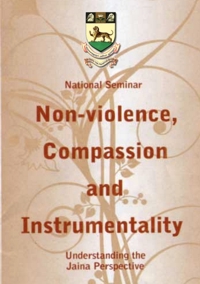Chennai 2009: Non-violence, Compassion and Instrumentality - A Jaina Perspective
 | Non-violence, Compassion and InstrumentalityA Jaina PerspectiveSeminar organized by the Department of Jainology of the University of Madras, 13 and 14 February 2009 Chennai, India |
Non-violence: The Role of 'Sat Samjhan' or True Understanding
13.2.2009
Introduction
This presentation will focus on the root cause of violence. Here’s a small story to begin with:
Once upon a time, there lived a poor farmer in the forest. One day he learnt that a tree that was growing in his backyard was a poisonous one and could kill anyone who would eat its leaves. Concerned about the harm the tree could bring to other unassuming living beings, the farmer climbed up the tree and started picking on the leaves of the tree. Once he had denuded the tree of all its leaves, he seemed satisfied. But within a week’s time all the leaves grew back. He wondered what to do. He decided to break the branches of the tree that had started to grow leaves back over again. His efforts were futile again when after a period of time the branches started to grow back again. This time he decided to chop off the trunk itself, but on doing so realized that even that was not going to help. This was when a friend suggested that he would have to nip the problem at its bud. He would have to uproot the tree.
Asat Samjhan or False Perceptions - Root cause for violence
We may have all heard this story several times in different forms. We have all heard and used phrases like ‘problem ko jad se ukhado’ ‘nip it at its bud,’ throughout our lives. So what is the root cause of violence? Is it poverty, unemployment, power struggle? No, it’s false perception or understanding of the state of things. Take any situation and trace it back to what caused it to happen in the first place. Example: Mumbai terrorist attack. If we possess the true understanding of right and wrong, of rightful conduct, we will be able to control our bhaav/ feelings for any situation, and this could help wipe out any possibility of violence, right?
Sat Samjhan or Truthful Understanding - Root cause for non-violence
What is this true understanding of the state of things of or true understanding of the substances that exist in this universe that can help us be in control of any situation? It is the fact that there are two main substances called matter and ātma [Self], jad and chetana; and that “I am the ātma”. Once we have understood this simple fact, we will be able to comprehend its implications. If I am the ātma and not the body; who is Deepika, the body or the soul? The soul does not require food, so why do I get irritated when I’m hungry. The soul has no form, it is ‘arūpa’ then why do I bother all day about how I look and worry about what people are thinking when they look at me.
I would like to quote my mentor Param Pujya Pappaji, also well-known as Shri Pravin Chandra Mehta here. He says, “Jo bandhan ka karan hai, wahi mukti ka karan hai, sirf drishti ka farak hai,” which means the factor which is causing the creation of karma is the same factor as which can help us get rid of karma or get freedom from karma. It’s just a matter of changing our angle of viewing things. In this sense, if false perception of understanding of the truth is the root cause of violence, if we take a 180 degree turn, once we know the truth and its implications on our behavior, non-violence and all other innate qualities of the soul will emerge.
How false perceptions cause violence of the ātma:
Every second and fraction of every second of our life is spent wastefully on unnecessary thoughts and feelings. Just track five minutes of your day. Note down every thought that comes to your mind when you are idle. Then determine how many of them were useful and how many were wasteful. While watching TV serials or reading newspapers or watching a cricket match, what are your feeling [bhaav] at that moment. ‘I could have done better than that. He doesn’t know to play, etc, etc.’ We are constantly comparing ourselves, measuring ourselves with the wrong yardstick, so how will we get the right answers? We are all ‘ātma’ and we think we are the body and we compare ourselves with other non-living “jad” substances. We will obviously never be able to live up to our comparisons. Because each individual is a result of his understanding of the state of things, of his resultant bhaav [bhāva] or feelings, and his karma. So no two individuals can be the same, because of a different package of karma.
When we are upset with the shape our life is taking, what is the first thought that comes to our mind. “Why me?” In fact, there isn’t one individual sitting in this audience who has not thought of these two words in his or her life. The answer to this question is ‘this is happening to you because you imagined it or you wished for it, did bhaav for it constantly or intermittently, ignorant of the fact that these wishes were actually going to come true. Because we remain ignorant of the existence of the soul, the result is anarchy and chaos.
Practical solution
When do you look for a solution? Once you realize that there is a problem. Recognizing this very problem, Lord Mahāvīra gave us the doctrine of “Ahiṁsā Paramo Dharma”. The greatest dharma of all is “ahiṁsā.” What is the meaning of dharma? It doesn’t mean religion. It means the basic nature. For instance, what is the dharma of sugar? It is to be sweet. Similarly what is the dharma of the jīva (soul) or all living beings - it is the basic nature of the soul. That is to gain knowledge. But we react to the knowledge we gain and end up creating karmas. By adding karmas we dilute the qualities of our soul which are “śantī [peace], samta [harmony], dāya [giving], and ahiṁsā [nonviolence] and several more. In this sense, Mahāvīra was the world’s greatest psychologist for his solutions to control the mind; the world’s greatest scientist for his theories on living and non-living things, and his proof of their existence through its practical implementations. The greatest social reformer of all times who realized the atrocities that women would be subjected to and who framed such a doctrine of ahiṁsā.
Lord Mahāvīra gave us the most practical solution to end violence of our own ātma and of others by gaining true understanding of one’s own self, one’s own ātma. He explained the pre-requisites to gain this knowledge, that is, the ‘Satguru’ - a ‘true’ guru who has himself realized ātma, who not only has heard that he is ātma but really knows it. He set an example that to acquire ‘true knowledge’, one didn’t require knowledge of the scriptures or spiritual texts, all one needed was true faith in one’s satguru, true feelings of love (prem or unconditional love) towards all living beings and true devotion (bhakti) towards God.
The most practical solution to violence or any other problem is to internalize the words “I am the ātma, I am different from everything else that exists in all the possible ways.” (Mein ātma hun, mein sarv se sarv prakar se bhinn hun.) Throughout the day and the night, every second when our mind is idle, if we practice to divert our mind from unnecessary thoughts and focus more on the basic nature of the soul, try to distinguish ourselves from the situation and from our body, slowly and steadily, we will find several positive changes in our self. But we have to remember not to give up easily. It will take months and years to unlearn old habits and train the ātma with these new instructions.
 Deepika Davey
Deepika Davey
